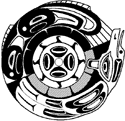
Summer Days, Winter Nights:
Planetarium show for Middle School Children
Pre-Show Activity 1
Shadow Stories
Objectives
- Students will reinforce the concepts of earth-sun relationships through demonstration and discussion.
- Students will analyze the physical description of a place in order to determine its latitudinal location.
- Students will create a place description with clues which will enable others to deduce the correct line of latitude.
Grade Level
7 - 12
Materials
- globe(s)
- flashlight
- 3 x 5 index cards with 3/4" hole
- copies of activity worksheets #1 and #2, "Shadow Stories" for each student
- atlases, maps, geography and earth science texts for student reference
Set-Up
Cut holes is 3 x 5 cards - trace a dime and cut out circle with scissors
Make all materials available to students
Procedure
- As review, demonstrate why direct rays of the sun are hotter than indirect rays. Create a ray of sun by shining a flashlight on a globe through a 3/4" hole cut in an index card. Hold the card about two inches from the globe and aim the direct ray so that it falls on the latitude farthest toward the sun. (Tropic of Cancer or Equator is seen best). The students will observe how the ray is concentrated brightly in a small area. Then, keeping the card and flashlight horizontal, move the ray northward toward the pole. The students will see that the heat ray spreads out over a larger area as the earth's surface curves. Consequently, the area receiving the indirect rays is cooler. (It is necessary to conduct this demonstration in different parts of the classroom for those students whose view is blocked by the card or the back side of the globe.)
- Review the changing seasons by having a student stand at the front representing the sun while another student revolves around him/her carrying either a globe or a Styrofoam ball marked with important parallels and having a dowel as the axis. The student who is orbiting the sun must be careful to hold the earth at a 23 1/2 degree tilt and to keep the poles pointing in the same direction. As the seasons change, ask questions of the class such as these:
- Where are the direct rays of the sun falling?
- Therefore, what season is it for us? for Argentina?
- What date is on the calendar? Is it a solstice? An equinox?
- What is the northernmost point that the direct rays hit? the southernmost point?
- During the course of the year, what is the pattern of movement of the direct rays?
- In what direction would your shadow lie at noon in December?
- How would your shadow lie if you were in Antarctica?
- If you have a sufficient number of globes, the class can be divided into small groups so that all students can have a turn in this exercise. Substitute globes can be made from paper plates and straws. On the back of the plates draw and label the Equator, both Tropics and Circles. Tape a straw on the front of one plate for the axis and then tape two plates together, back sides out. The drawback to these "globes" is that they are flat and some students have difficulty envisioning the sun's rays falling on the equator. The advantage is that they are inexpensive and made of handy materials.
- Pass out Activity Worksheet Shadow Stories
- Have the students read the Problem and Observations.
- Direct the students to answer in writing questions 1-3, working individually.
- Place students in groups of four to discuss their choices and reasons (which should lead to the selection of the Tropic of Capricorn) and to write answers to the proceeding questions.
- Have each group select a reporter to share the group's findings with the class.
- Assign Part B from the Activity Worksheet
- Assign the students to create their own place descriptions. This can be done by individuals for homework or in groups as a class exercise.
- Have the students present their place descriptions to the class for solutions. This can be done in several ways:
- Selected students could write them on the board
- Selected students could read theirs while the class members write down key terms
- Groups could exchange their place descriptions
- Conclude the lesson with a class discussion of the thinking strategies that they used to decide on locations
- Use these situations to test or discuss as a means of checking for understanding:
Your exploration team keeps getting lost in its world-wide journeys as it travels along the 50 degree east line of longitude. Use the following descriptions to determine your correct latitudinal location.
- ____ "It is midnight by my watch, which shows the date to be Dec. 15th, and yet I can write these notes by natural light, for the sun remains above the horizon."
- Equator
- Tropic of Cancer
- Arctic Circle
- Antarctic Circle
- ____ "There are stretches of barren sand and rock formations as far as we can see in all directions. Even though we shivered through the night, we feel as if we will perish from the heat during the day. My journal tells me that it is the 12th of March, and as we trudge northward at noon our shadows extend before us."
- Antarctic Circle
- Tropic of Cancer
- Tropic of Capricorn
- Equator
- ____ "We have been adrift in our life raft for a day now, and the heat would do us in except for the heavy rainfall. We drifted past an island covered with lush green vegetation but could not reach shore. It is Sept. 23rd, and as the sun sets in the west, we notice that our shadows stretch out directly eastward."
- Tropic of Cancer
- Equator
- Tropic of Capricorn
- Arctic Circle
